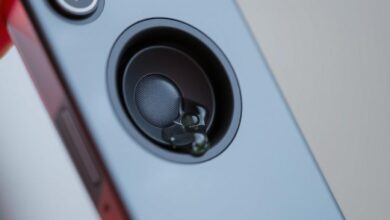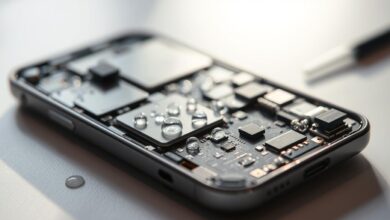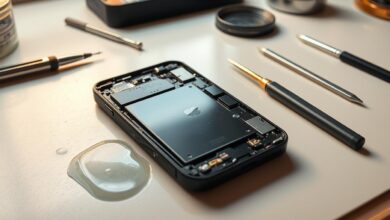how to fix speakers on iphone
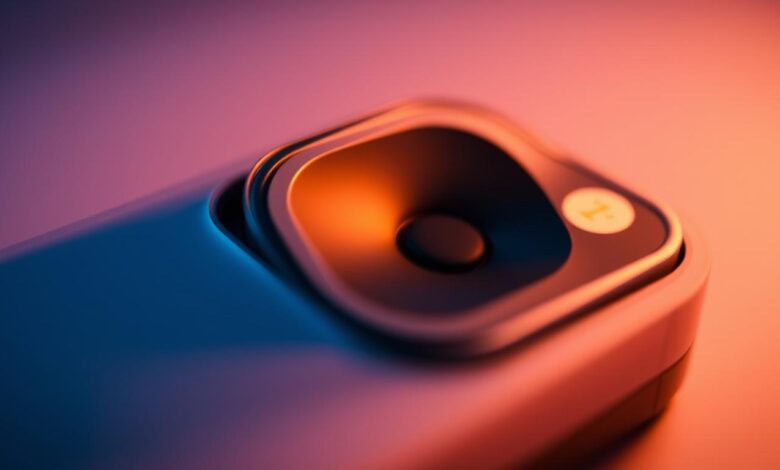
Dealing with iPhone speaker issues can be really frustrating. Especially when you’re in the middle of an important call or listening to your favorite music. As an expert, I’ll show you how to troubleshoot and repair common iPhone speaker problems.
Whether you’re facing no sound, distorted audio, or low volume, this guide has got you covered. I’ll share my knowledge to help you fix these issues quickly.
Key Takeaways
- Identify common iPhone speaker issues
- Learn troubleshooting steps for iPhone speaker problems
- Discover repair options for iPhone speakers
- Understand how to prevent future speaker issues
- Get tips for maintaining your iPhone’s audio quality
Understanding iPhone Speaker Systems
To fix iPhone speaker problems, knowing how the speaker system works is key. The iPhone’s sound comes from both hardware and software parts. When you face issues like “iPhone sound not working,” understanding these parts helps find the problem’s source.
Different Types of Speakers on iPhones
iPhones have several speakers for different uses. The earpiece speaker is for calls, while the loudspeaker plays music and videos. Some iPhones also have stereo speakers for better sound. Knowing what each speaker does is important for solving problems.
How iPhone Speakers Function
iPhone speakers work together through hardware and software. The audio codec changes digital audio into sound the speakers can play. If you have issues like “iPhone speaker not producing sound,” it could be a codec, hardware, or software problem. Keeping your iPhone in good shape helps speakers work well.
Common Signs of iPhone Speaker Problems
Knowing the signs of iPhone speaker problems is key to fixing them. When your iPhone’s speaker acts up, it shows in different ways. It’s important to spot these signs to fix the issue fast.
No Sound Issues
One clear sign is when your iPhone makes no sound at all. This could be from a software bug, water damage, or a broken part. If your iPhone is silent, even with the volume up, there’s likely a speaker problem. First, check the volume settings and make sure silent mode is off.
Distorted Audio Problems
Distorted audio is another common problem. If your iPhone’s sound is fuzzy or crackling, it might be a hardware or software issue. This can be really annoying, especially when you’re listening to music or on a call.
Volume Inconsistencies
Volume that changes randomly or is too low can also point to a problem. If your volume is all over the place or too soft, it might be a speaker or audio setting issue. Look at the volume limit settings to see if it helps.
Buzzing and Crackling Symptoms
Strange sounds like buzzing or crackling from your iPhone’s speaker are clear signs of trouble. These sounds can come from dirt in the speaker or a hardware problem. Sometimes, cleaning the speaker grill can fix it.
Some common signs of iPhone speaker problems include:
- No sound or complete silence
- Distorted or fuzzy audio
- Inconsistent or low volume
- Buzzing or crackling sounds
Spotting these signs is the first step to fixing the problem. If you’re facing any of these issues, it’s crucial to troubleshoot or get professional help to get your iPhone’s speaker working again.
Basic Troubleshooting Steps for iPhone Speakers
Before looking at complex fixes, try simple checks first. These steps can help find and fix common iPhone speaker problems.
Checking Volume Settings and Silent Mode
First, make sure your iPhone’s volume is up and not in silent mode. Sometimes, the volume might be down or silent mode might be on. Check the volume buttons and the silent switch to fix this.
Restarting Your iPhone
Restarting your iPhone can solve many issues, including speaker problems. Press and hold the sleep/wake button until you see “Slide to Power Off.” Slide it to the right to turn off your iPhone. Then, press and hold the sleep/wake button again until you see the Apple logo.
Testing Different Audio Sources
Try playing audio from different sources to see if the problem is with one app. For example, if music isn’t working, try a video or another song. Check if the problem happens in different apps like Music, YouTube, or Phone. If it’s just one app, update or reinstall it. For more help, visit this resource for more steps.
Checking Bluetooth and Headphone Connections
iPhone speakers might not work if connected to Bluetooth or headphones. Go to Settings > Bluetooth to check for connections. If you see a device, tap the “i” icon next to it and select “Disconnect” or “Forget Device.” Also, make sure no headphones are plugged in, as they can change where audio goes.
How to Fix Speakers on iPhone When There’s No Sound
When your iPhone’s speakers stop working, it’s really frustrating. This problem can come from software bugs, hardware problems, or water damage. We’ll look at how to fix it.
Software Solutions for Silent Speakers
First, check if it’s a software problem. Try restarting your iPhone. This can fix temporary bugs. Also, make sure your iPhone has the latest iOS. Updates often fix bugs that cause speaker issues.
Look at your iPhone’s settings too. Make sure the volume is up and silent mode is off. Sometimes, just changing a setting can fix it.
Hardware Checks for No Sound Issues
If software fixes don’t work, check the hardware. Look for dust or debris in the speaker grills. Cleaning them with a soft brush or cloth might help.
Also, check for any damage like cracks or dents. These could mean the speakers are broken.
| Hardware Issue | Potential Solution |
|---|---|
| Debris in Speaker Grills | Clean with a soft brush or dry cloth |
| Physical Damage to iPhone | Inspect for cracks or dents, consider repair |
| Water Exposure | Dry the iPhone, avoid charging until dry |
Fixing Sound After Water Exposure
If your iPhone got wet, that might be why the speakers are silent. First, dry it right away. Don’t charge it until it’s completely dry. Use silica gel packets or uncooked rice to dry it out.
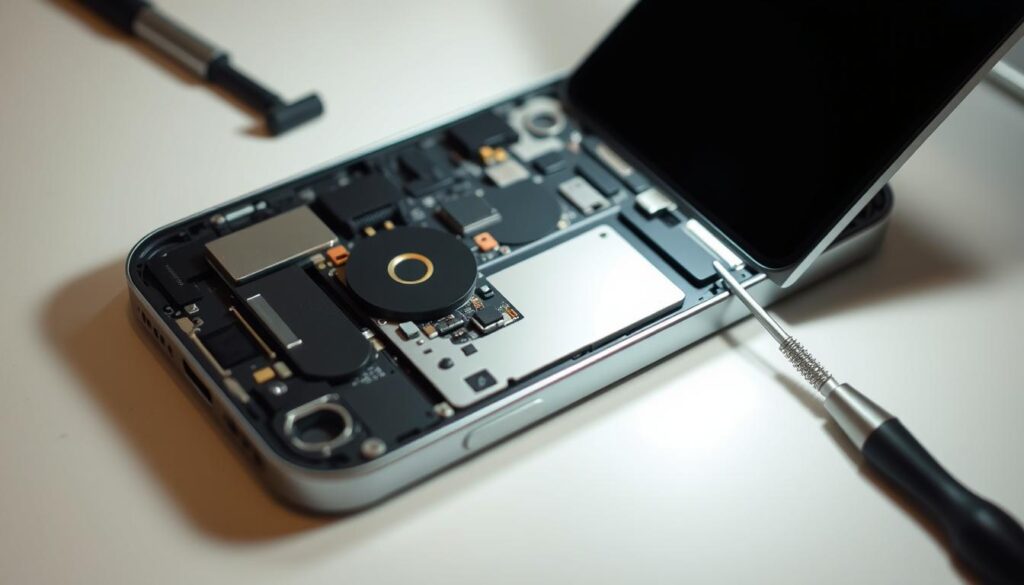
If it still doesn’t work after drying, you might need to go to an Apple Store or an authorized service provider for help.
Resolving iPhone Speaker Crackling and Distortion
When your iPhone’s speaker crackles or distorts, figuring out if it’s a software or hardware problem is key. This helps you know how to fix it. These issues can ruin your experience, whether you’re watching videos, listening to music, or making calls.
Software Causes of Audio Distortion
Software problems often lead to audio distortion on iPhones. It could be a bug in the operating system or an issue with a specific app. First, check if your iPhone is up to date with the latest iOS. This update can fix bugs causing the distortion.
Another cause might be the equalizer settings or other audio enhancements in the Music app or other media players. Try changing these settings or turning off enhancements to see if they’re the problem.
Hardware-Related Crackling Solutions
If it’s not a software issue, it’s likely a hardware problem. Dirt, dust, or debris in the speaker grill can cause crackling. Clean the grill with a soft-bristled brush or a dry cotton swab. Water damage could also be the culprit. If your iPhone got wet, dry it out and seek help if the problem doesn’t go away.
In some cases, you might need a professional to fix or replace the hardware. If your iPhone is still under warranty or covered by AppleCare+, you might get it fixed or replaced for free.
App-Specific Audio Troubleshooting
Distortion or crackling might be specific to one app. Try playing audio through different apps to see if the problem is everywhere. If it’s just one app, update the app or reinstall it. Also, check the app’s settings for audio enhancements and turn them off.
By checking both software and hardware, you can find and fix the problem with your iPhone’s speaker.
Fixing Low Volume Issues on iPhone Speakers
Low volume from your iPhone speakers can be frustrating. But, knowing the reasons and fixes can help. Issues can come from software settings, blockages, or debris in the speaker grills.
Volume Limit Settings Check
One common reason for low volume is the Volume Limit setting. To check it, go to Settings > Music > Volume Limit. Make sure the volume isn’t capped too low. Adjusting this setting might fix the problem if the limit was too low.
For more help, check out OS X Daily. They have great guides on fixing call sound issues on iPhones.
Cleaning Speaker Grills Safely
Debris and dust on the speaker grills can lower the volume. Use a soft-bristled brush or a dry cotton swab to clean. Gently sweep away debris, avoiding hard pressure that could harm the speakers. 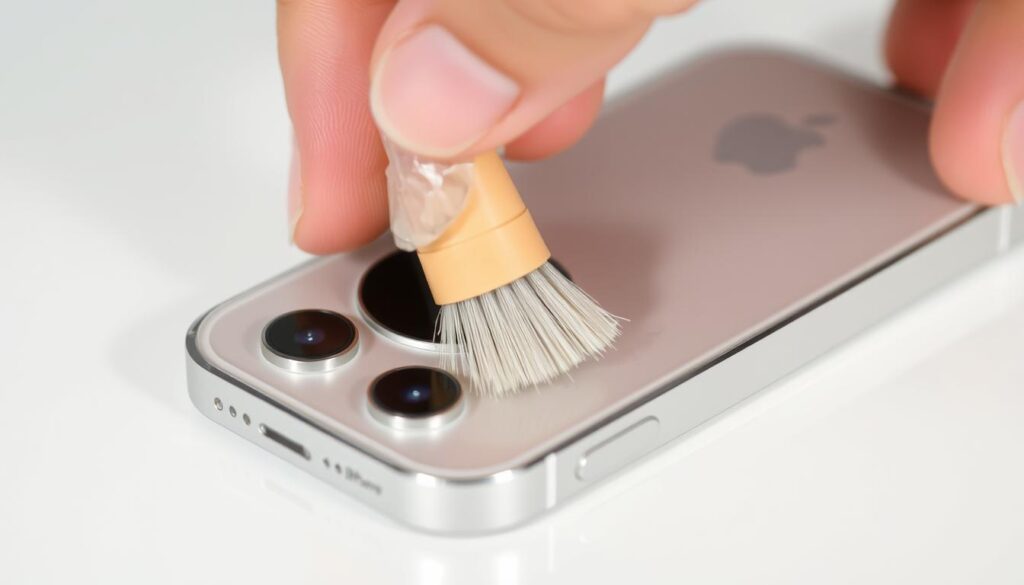
This easy maintenance can often fix the volume. Regular cleaning helps prevent future problems.
Software Settings That Affect Volume
Certain software settings can change your iPhone speakers’ volume. For example, the EQ settings under Settings > Music > EQ can affect the sound. Try different EQ settings or turn it off to see if it helps.
Also, check the Reduce Loud Sounds option under Settings > Accessibility > Audio/Visual. Make sure it’s not enabled or is set right. This setting can also reduce the maximum volume.
Addressing iPhone Speaker Problems After iOS Updates
Speaker issues after an iOS update can be annoying. But, there are ways to fix them. Sometimes, an update can mess with your iPhone’s speaker. This might cause no sound, distorted audio, or other problems.
Post-Update Audio Troubleshooting
After an iOS update, it’s key to check your iPhone’s speaker. First, make sure the volume is turned up and your device isn’t in silent mode. Try restarting your iPhone to see if it fixes the problem.
If it still doesn’t work, play different audio to see if it’s just one app or file. Also, clean the speaker grills of any dust or debris. A soft brush or cloth can help fix the issue.
Reverting or Updating iOS for Speaker Fixes
If your speaker still isn’t working after an update, you might want to go back to an older iOS version or update to the newest one. Going back to an older version can be tricky and might need a pro’s help. But, updating to the latest version might fix known problems, including audio ones.
To update, go to Settings > General > Software Update. If there’s an update, follow the instructions to download and install it. Always back up your device before a big update.
Reporting Audio Bugs to Apple
If you’ve tried everything and still have speaker issues, report it to Apple. You can contact Apple Support online or visit an Apple Store. Tell them all about your problem and what you’ve tried so far.
Reporting bugs helps Apple make their products better. It also makes using your iPhone better for everyone. By reporting your issue, you’re helping to fix problems for future updates.
Solving iPhone Speaker Buzzing Problems
The buzzing noise from your iPhone speaker can be caused by software or hardware problems. I’ll show you how to fix it. This buzzing can ruin your music, calls, or other sounds. Knowing the cause is key to finding the right solution.

Identifying Causes of Speaker Buzzing
There are many reasons for iPhone speaker buzzing. Software bugs can cause audio problems. Hardware issues like dirt in the speaker or water damage also lead to buzzing.
It’s important to figure out if it’s a software or hardware problem. This helps you find the right fix.
Software Fixes for Buzzing Sounds
For buzzing caused by software, try restarting your iPhone or updating to the latest iOS. Also, check for app updates and reset all settings. This might stop the buzzing.
See if the buzzing happens with all apps or just one. This can help you find the source of the problem.
Hardware Solutions for Persistent Buzzing
If the buzzing doesn’t go away, it might be a hardware issue. Try cleaning the speaker grills with a soft brush or cloth. This can remove dirt causing the buzzing.
If it’s more serious, like water damage, you might need to visit an Apple service center. They can fix or check your iPhone.
| Cause | Software or Hardware | Potential Fix |
|---|---|---|
| Software Glitch | Software | Restart iPhone, Update iOS |
| Debris in Speaker | Hardware | Clean Speaker Grill |
| Water Damage | Hardware | Visit Apple Service Center |
Advanced Solutions for Persistent Speaker Issues
When basic steps don’t fix iPhone speaker problems, it’s time for advanced solutions. These issues can be really frustrating. But, there are ways to get your iPhone’s sound working again.
Resetting All Settings
Resetting all settings can fix speaker issues by going back to default values. This doesn’t delete your important data like contacts or photos. But, it will change your preferences, including Wi-Fi passwords and wallpaper.
To reset all settings, go to Settings > General > Reset and choose “Reset all settings.” You might need to enter your passcode or Apple ID password to confirm.
Restoring iPhone to Factory Settings
If resetting all settings doesn’t work, you might need to restore your iPhone to factory settings. This is a more serious step. It erases everything and brings your iPhone back to its original state.
Make sure you have a recent backup before you start. To restore your iPhone, go to Settings > General > Transfer or Reset iPhone, then tap “Erase All Content and Settings.” Follow the instructions on the screen to finish.
Using Recovery Mode for Audio Problems
Recovery mode is a more advanced step for serious software issues, including speaker problems. You’ll need a computer with iTunes to do this.
First, connect your iPhone to the computer and open iTunes. Then, follow these steps for your iPhone model: For iPhone 8 or later, quickly press and release the Volume Up button, then the Volume Down button, and finally press and hold the Side button until you see the recovery mode screen. For iPhone 7 or 7 Plus, press and hold both the Volume Down and Sleep/Wake buttons for at least 10 seconds until you see the recovery mode screen.
Once in recovery mode, iTunes will detect your iPhone and ask you to restore it. Just follow the on-screen instructions to finish the restoration.
| Troubleshooting Step | Description | Impact on Data |
|---|---|---|
| Reset All Settings | Reverts customized settings to default | No data loss |
| Restore to Factory Settings | Erases all content and settings | All data erased |
| Recovery Mode | Restores iPhone through iTunes | All data erased if not backed up |
Physical Cleaning Methods for iPhone Speakers
To get the best sound from your iPhone, cleaning the speakers is key. Dirt, dust, and debris can mess with the sound, leading to iPhone speaker crackling or iPhone speaker volume low. Cleaning your iPhone’s speakers is easy and can make a big difference in sound quality.
Safe Cleaning Tools and Materials
Choosing the right tools for cleaning your iPhone’s speakers is important. You’ll need a soft-bristled toothbrush, compressed air, and a microfiber cloth. Stay away from sharp objects, rough materials, and liquids to avoid damage.
Step-by-Step Speaker Cleaning Process
Here’s a simple guide to clean your iPhone’s speakers:
- Gently brush the speaker grills with a soft-bristled toothbrush to remove visible debris.
- Use compressed air to blow out any remaining dust or dirt. Hold the can upright and spray the air in short bursts.
- Wipe the speaker grills with a microfiber cloth to remove any remaining dust or debris.
After cleaning, test your iPhone’s speakers to see if the sound quality has improved.
| Cleaning Method | Effectiveness | Safety |
|---|---|---|
| Soft-bristled toothbrush | High | Safe |
| Compressed air | High | Safe if used correctly |
| Microfiber cloth | Medium | Very Safe |
What to Avoid When Cleaning Speakers
It’s also important to know what not to do when cleaning your iPhone’s speakers. Liquids can damage the internal parts. Don’t insert sharp objects into the speaker grills, as it can cause harm. Also, avoid harsh chemicals or abrasive materials that can damage the speaker’s surface.
When to Seek Professional Repair for iPhone Speakers
If your iPhone speaker isn’t working right, you need to figure out if it needs a pro fix. Some problems can be fixed easily, but others mean serious damage that only experts can fix.
Signs of Serious Speaker Damage
Signs of serious damage include:
- Persistent distortion or crackling sounds
- No sound output despite thorough troubleshooting
- Physical damage to the speaker grill or surrounding area
- Water damage that affects the speaker’s functionality
If you see these signs, your iPhone speaker likely needs a pro repair. For more info on fixing common speaker problems, check out this resource.
Apple Support vs. Third-Party Repair Options
You have two main choices for repair: Apple Support or third-party services. Apple offers genuine parts and keeps your warranty valid, but it’s pricier. Third-party services are cheaper but might use non-genuine parts and risk voiding your warranty.
Key considerations:
- Genuine parts vs. non-genuine parts
- Warranty implications
- Cost differences
Typical Repair Costs and Timeframes
Repair costs and times vary based on the problem and the service. iPhone speaker fixes usually cost between $50 and $200. Apple Support tends to be more expensive. Third-party services might be quicker but make sure they use good parts.
Knowing these details helps you choose the right place for your iPhone speaker repair.
Preventive Measures to Protect iPhone Speakers
To keep your iPhone’s speakers working well, it’s key to take steps to prevent damage. This helps avoid issues like iPhone speaker not producing sound. Being proactive can also help keep your sound quality high.
Avoiding Water and Debris Damage
Water and debris can harm your iPhone’s speakers. Be careful when using your iPhone near water or in dusty places. A waterproof case adds extra protection.
Also, clean the speaker grills with a soft brush often. This removes debris that can mess with sound quality.
Safe Volume Practices
Playing music too loud can damage your iPhone’s speakers. Keep the volume down and use volume limiting to avoid loud sounds. This protects your speakers and your hearing.
Protective Cases and Their Impact on Sound
Protective cases are great for keeping your iPhone safe, but some can affect sound. Pick a case that lets sound flow freely from the speakers. Stay away from cases with thick or hard parts that cover the speakers. They can block sound or cause iPhone sound not working problems.
Conclusion
Fixing iPhone speaker problems needs a step-by-step approach. This includes basic checks and advanced fixes. Knowing how the iPhone’s speakers work and what common issues are helps you find the right solution.
We’ve looked at many ways to fix iPhone speaker issues. This includes checking software and hardware, cleaning the speaker grills, and dealing with iOS updates. Using these methods should help you solve most speaker problems on your iPhone.
To keep your iPhone’s speakers working well, take care of them. Avoid water and use protective cases. Clean the speaker grills often and keep an eye on your volume. If these steps don’t work, you might need professional help or Apple support. They can guide you on how to fix your iPhone speakers.
FAQ
Why is my iPhone speaker not producing sound?
There are many reasons your iPhone speaker might not work. It could be in silent mode, have a software problem, or a hardware issue. Check your volume settings, restart your iPhone, and test different audio sources to find the problem.
How do I fix distorted audio on my iPhone?
Distorted audio can come from software or hardware problems. Try restarting your iPhone, updating your software, and testing different audio sources. If it still doesn’t work, check your iPhone’s hardware for damage or debris.
Why is my iPhone speaker volume too low?
Low volume can be due to debris in the speaker, software settings, or a hardware issue. Clean the speaker grill safely, check your volume limit settings, and adjust software settings to fix it.
Why is my iPhone speaker crackling or buzzing?
Crackling or buzzing sounds can be from software glitches, hardware problems, or debris. Restart your iPhone, update your software, and clean the speaker grill to solve the problem.
What should I do if my iPhone speaker is not working after an iOS update?
If your speaker stops working after an update, restart your iPhone, check for more updates, and troubleshoot audio issues. You might need to contact Apple or go back to a previous iOS version.
How do I clean my iPhone speaker safely?
To clean your speaker safely, use a soft-bristled brush or a dry cotton swab. Gently remove debris from the speaker grill. Avoid liquids, sharp objects, or abrasive materials that can harm the speaker.
When should I seek professional repair for my iPhone speaker?
Seek professional repair if basic troubleshooting doesn’t work or if you see serious damage. This includes physical trauma or water damage.
How can I prevent iPhone speaker problems?
To avoid speaker problems, keep your iPhone away from water and debris. Use safe volume levels and protective cases that don’t affect sound quality. Regularly clean your iPhone’s speaker grill to keep it working well.
Can a faulty headphone jack or Bluetooth connection affect my iPhone speaker?
Yes, a bad headphone jack or Bluetooth connection can cause speaker issues. Check your headphone jack for debris, restart your iPhone, and verify your Bluetooth connections to fix it.
Will resetting all settings on my iPhone fix speaker issues?
Resetting all settings can sometimes solve speaker problems caused by software settings. But be careful, as it will reset all your customized settings to their defaults.
